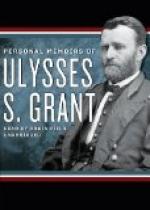There had been great delay in obtaining the authority of Congress for the raising of the troops asked for by the administration. A bill was before the National Legislature from early in the session of 1846-7, authorizing the creation of ten additional regiments for the war to be attached to the regular army, but it was the middle of February before it became a law. Appointments of commissioned officers had then to be made; men had to be enlisted, the regiments equipped and the whole transported to Mexico. It was August before General Scott received reinforcement sufficient to warrant an advance. His moving column, not even now more than ten thousand strong, was in four divisions, commanded by Generals Twiggs, Worth, Pillow and Quitman. There was also a cavalry corps under General Harney, composed of detachments of the 1st, 2d, and 3d dragoons. The advance commenced on the 7th of August with Twiggs’s division in front. The remaining three divisions followed, with an interval of a day between. The marches were short, to make concentration easier in case of attack.
I had now been in battle with the two leading commanders conducting armies in a foreign land. The contrast between the two was very marked. General Taylor never wore uniform, but dressed himself entirely for comfort. He moved about the field in which he was operating to see through his own eyes the situation. Often he would be without staff officers, and when he was accompanied by them there was no prescribed order in which they followed. He was very much given to sit his horse side-ways—with both feet on one side—particularly on the battlefield. General Scott was the reverse in all these particulars. He always wore all the uniform prescribed or allowed by law when he inspected his lines; word would be sent to all division and brigade commanders in advance, notifying them of the hour when the commanding general might be expected. This was done so that all the army might be under arms to salute their chief as he passed. On these occasions he wore his dress uniform, cocked hat, aiguillettes, sabre and spurs. His staff proper, besides all officers constructively on his staff—engineers, inspectors, quartermasters, etc., that could be spared—followed, also in uniform and in prescribed order. Orders were prepared with great care and evidently with the view that they should be a history of what followed.




